In February, 2021, "Hu Wensui Art Museum" was inaugurated in the Ancient City Park in Huangpu District. It used to be the former site of Hunan Qianye Office. Today, this white-walled gray tile building with Huizhou style meets the public with a new look. Hu Wensui is a famous calligrapher in contemporary China and a representative of Shanghai style calligraphy. More than 100 calligraphy and paintings of Mr. Hu Wensui at various stages are displayed in the museum. Two years ago, on behalf of her family, Mrs. Hu Wensui donated nearly 1,000 pieces of Hu Wensui’s works to the Huangpu District People’s Government. Now, with the completion of the Art Museum, Shanghai Huangpu has added a cultural business card.
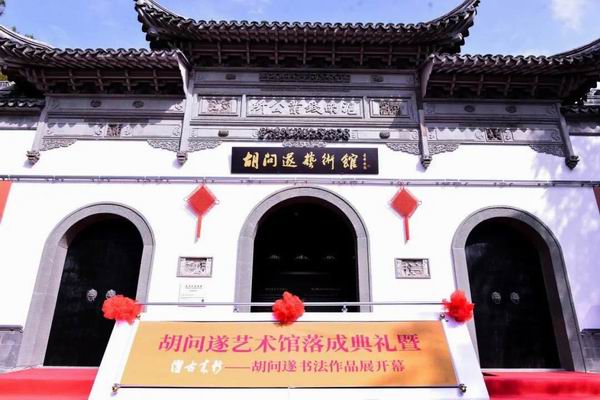
Hu Wensui Art Museum Inauguration Ceremony
Hu Wensui was born in 1918. He studied calligraphy with Mr. Shen Yinmo in the early 1950s. Prior to this, he also had two experiences in the military and business respectively. Compared with calligraphy attainments, the world knows little about another legendary experience of Hu Wensui: designing a trademark for "Lai Mao" wine.
First, Hu Wensui’s career in the home front
When the Anti-Japanese War broke out in 1937, Hu Wensui was less than 20 years old. He joined the propaganda team of the Political Propaganda Department of the 105th Division of the National Revolutionary Army. The 105th Division was adapted from Zhang Xueliang’s guard during the "Xi ‘an Incident". Wang Tiehan, the division commander, once refused to carry out the "non-resistance" order during the "September 18th Incident" and fired the first anti-Japanese shot in Northeast China. The 105th Division went all the way to the west, and successively participated in Changsha Battle and Nanchang Battle. Hu Wensui also went to the mainland to engage in propaganda work with the army.
In 1941, China entered the most difficult stage of the Anti-Japanese War. The territory in the southeast fell, and the rear area suffered an unprecedented military blockade. Yunnan-Guizhou became the only channel for the Allies to transport goods to China. This year, Hu Wensui went to Lashuo, Myanmar with the army, worked as a mechanic in the transportation department and participated in the construction of the Yunnan-Myanmar Highway. Later, due to illness, Hu Wensui left the army and temporarily stayed in Guiyang. After his military career came to an end, Hu Wensui began to consider the way of industry. Because he is good at calligraphy and painting, he first opened a small shop in Guiyang to undertake trademark advertising and printing business, and later opened a small printing factory. During his years in Guiyang, Hu Wensui made friends with people from Guizhou’s industrial and commercial circles for support.

Mr. Hu Wensui (1918-1999)
At this time, Lai Yongchu has become an influential leader in Guizhou’s industrial and commercial circles. Lai Yongchu is a native of Guiyang. His family started with groceries trade and loans in the early years, and gradually grew from "twenty taels of silver" to tens of thousands of wealthy businessmen. Lai Yongchu, the son of Lai’s parents, took charge of the bank business after inheriting the family business. In 1936, Lai Yongchu founded Daxing Industrial Company to expand its business scope. After having more money, Lai Yongchu started his business activities in Guiyang and joined the social circle of Guizhou Chamber of Commerce. Around 1940, Lai Yongchu entered the Guiyang Chamber of Commerce and served as the executive director. With the help of the organizational strength of the Chamber of Commerce, he successively founded Guizhou Business Daily and Guiyang Business Friends Club to serve local businessmen. During the Anti-Japanese War, Lai Yongchu also served as a senator in Guiyang and a bank manager in Guiyang.
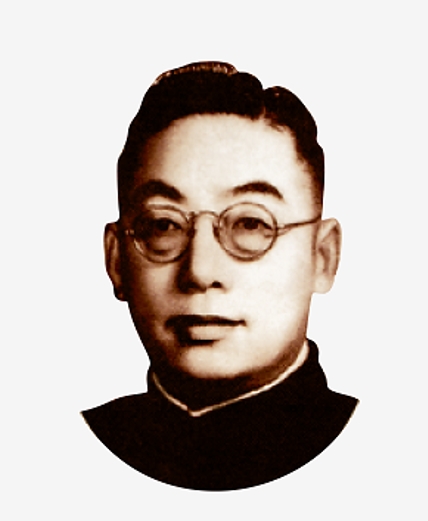
Mr. Lai Yongchu (1902-1981)
In 1937, due to poor management, the former Hengchang Burning House in Maotai Town, the shopkeeper Zhou Bingheng took a stake in Daxing Industrial Company in Lai Yongchu with the winery. In 1941, Zhou Bingheng resold the winery to Lai Yongchu. After Lai Yongchu took over, he renamed it "Hengxing Winery" and introduced a new product: Laimao.
Brewing was originally the tip of the iceberg in Lai Yongchu’s business empire, but later it became the most famous brand. The acquaintance and cooperation between Hu Wensui and Lai Yongchu also started from "Lai Mao".
After Lai Yongchu named the product "Lai Mao", he began to organize the design of trademarks. Almost at the same time, Hu Wensui and Lai Yongchu met. Therefore, the design of "Lai Mao" trademark was undertaken by Hu Wensui. The trademark of "Lai Mao" is a Dapeng bird pattern, and it symbolizes the world with a ring as the background. The Roman pinyin "Lay Mau" of "Lai Mao" is printed on the top of the Trade Mark, and the English logo "Trademark" (meaning registered trademark) is printed on the bottom. In 1943, Hu Wensui established a firm foothold in Guiyang and opened the "Shilun Printing Factory". Since then, the trademarks of "Lai Mao" wine have been printed by Shilun Printing Factory.
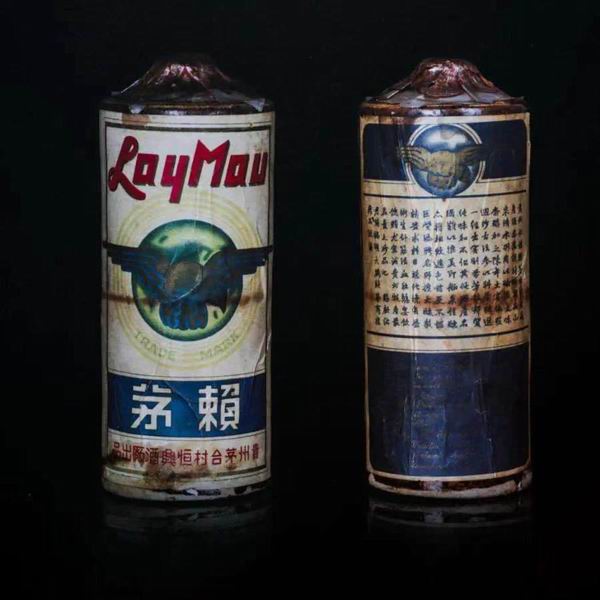
"Lai Mao" Bottle Trademark in the Republic of China
The trademark design of "Laimao" wine has incorporated many modern business ideas. Previously, most of the trademarks of Maojiu were not fastidious enough. For example, when Huajia Chengyi Shaofang Maojiu applied for a trademark in 1940, it was only marked with the words sorghum spike and "Huisha Maojiu". After the product name and trademark of "Lai Mao" came out, various wineries followed suit. Later, Chengyi Shaofang also called its maojiu "Huamao", and the Ronghe Shaofang of the Wang family also called itself "wangmao". Many imitation Mao wines outside Maotai Town also use this title, and imitation Mao wines such as "Jinmao", "Dingmao" and "Yuemao" emerge one after another in the market.
The story about the falsification of Moutai is not only in today’s market. Let’s take a look at Lai Yongchu’s own memories:
"In the old society, everyone just made money, and there was no credibility at all. It was really impossible to stop counterfeiting. Not only is it popular in Guiyang to sell fake maojiu, but even on the way from Guiyang to neighboring provinces, hotels sell fake maojiu, some print trademarks as fake maojiu, and some dry-recycle empty maojiu bottles, one in a corner, and then put sorghum wine as maojiu, which makes a lot of profits. "
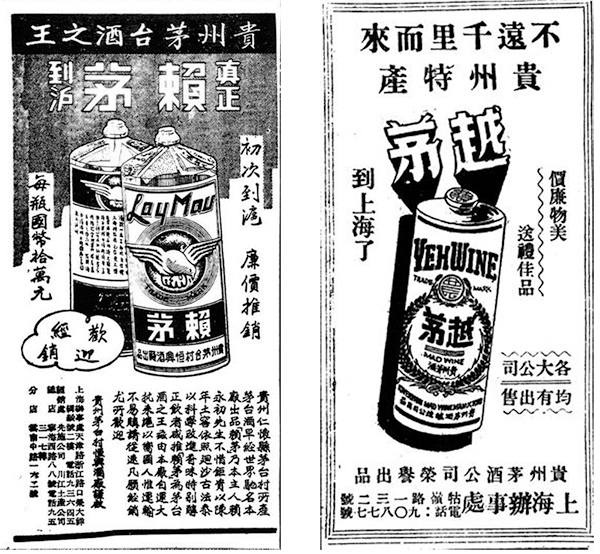
"Lai Mao" wine advertisement and "Yue Mao" wine advertisement imitating Lai Mao trademark in the Republic of China
Second, the cooperation between Hu and Lai and the rise of Maotai liquor
Modern Moutai generally originated in the late Qing Dynasty and was first managed by salt merchants. At the end of the 19th century, the brewing workshops in Maotai Town included the "Chengyi Burning House" of the Fahrenheit family and the "Ronghe Burning House" of the Wang family. In the 1920s, Zhou Bingheng, a businessman from Guiyang, opened the Hengchang Burning House in Maotai Town, and since then, there have been three wineries in Maotai Town. In the 1940s, Lai Yongchu acquired Hengchang Shaofang and renamed it Hengxing Winery. Hengxing Winery is the youngest of the three wineries in Maotai Town, but by the time of the victory of the Anti-Japanese War, it has become the largest winery. This is closely related to the luck, business opportunities and brand management in Lai Yongchu.
After the outbreak of the Anti-Japanese War, the National Government moved westward to Chongqing, and a large number of military officials moved inward. Hundreds of thousands of military and political personnel moved inward, which brought huge consumer demand. Maotai liquor was gradually welcomed by the upper class because of its high price and scarcity. Whether it’s the official reception of military and political high-level officials or the social gifts of writers and writers, Moutai appears in their daily lives, which is of course in sharp contrast with the poor life of middle and lower-level civil servants in the rear area.
Throughout the Republic of China, the price of Mao wine has been at a high level. Before the outbreak of the Anti-Japanese War, the price of a bottle of Mao wine was about 1 silver dollar, and it was necessary to add 1-2 cents to buy it from the agency. After the outbreak of the Anti-Japanese War, the Kuomintang-controlled areas began to experience serious inflation, and the price of Mao wine was also rising. According to the Shanghai newspaper in January, 1946, "Lai Mao" liquor was "sold for 5,000 French francs in Chongqing, and the counterfeit currency was one million yuan". By November 1946, a bottle of Mao wine would cost 25 thousand yuan.
After the war, Moutai also broke through the southwest corner and sold to the whole country. In 1946, Chongqing Credit Information News reported as follows: "Moutai produced in Renhuai, Guizhou Province, has a mellow taste and is well-known. Before the Anti-Japanese War, it was sold all over the country. Due to the war, the sales area was gradually reduced, only the rear area was used as the sales area, and the transportation convenience area was gradually restored. The oldest Moutai company, Cheng Yi Heng Xing Rong and the three companies, had an annual output of several hundred thousand Jin, and it was still being promoted in Guangzhou, Beijing and Shanghai due to their achievements.
After the victory of the Anti-Japanese War, Shilun Printing Factory and Hengxing Winery have already taken shape. Hu Wensui Shilun Printing Factory reached the scale of "more than 100 employees and two rubber offset presses", while there were only five printing equipments in Guiyang at that time. The printing factory undertakes the printing business of teaching materials, literature, history and scientific research books. Hu Wensui, 30, has become a rising star in Guiyang’s cultural and business circles. In 1950, facing the new situation, Hu Wensui made a choice. He took the initiative to hand over the printing factory to the Guizhou provincial government, and the Shilun Printing Factory was merged into Guizhou People’s Printing Company, and later changed to Guizhou Xinhua Printing Factory, and embarked on the track of state-owned. Hu Wensui moved his family to Shanghai and began his calligraphy life.
Lai Yongchu’s career in Guiyang has also further grown. He once served as the general manager of Guizhou Provincial Bank, mastering the financial lifeline of Guizhou, and concurrently engaged in salt industry, mining industry, newspaper industry, charity and education. Looking back at the history of Lai Yongchu’s commercial prosperity, the rapid growth of its wealth and even its social status is almost synchronous with the growth of Guizhou’s wartime economic status. By entering the Chamber of Commerce, Lai Yongchu began to frequently deal with high-ranking military and political figures in Guizhou, and presented them with "Lai Mao" wine as a gift. After the Kuomintang retreated to Taiwan Province, Guizhou was not liberated. Because of Lai Yongchu’s position in the financial world, Gu Zhenglun, then chairman of Guizhou Province, persuaded Lai Yongchu to go to Taiwan Province and asked him to ship all the funds of Guizhou Bank to Taiwan Province, and left a plane waiting in Xingren. In the end, Lai Yongchu chose to stay in Guizhou to welcome the new regime.
From a larger historical background, the story of Hu Wensui’s participation in Lai Mao’s trademark design outlines the social mobility of China when he went to war. Before the Anti-Japanese War, Guizhou was located in the border and the traffic was blocked. In wartime, the National Government used the central finance to develop southwest transportation, and Guizhou became a transportation hub in the rear area. In addition, the inward migration of personnel has also brought a large number of talents to the southwest. The cooperation between Lai Yongchu and Hu Wensui is the embodiment of this social mobility.
Third, the "Lai Mao" international movement under the background of marketization
It can be said that the popularity of Moutai in the Republic of China, especially in the rear area of the Anti-Japanese War, laid the foundation for becoming a national famous wine in one fell swoop after 1949. In 1950, Lai Yongchu went to Beijing with the "Kunzhu delegation" from Yunnan-Guizhou New Liberated Area, and was invited to attend the first anniversary ceremony of the National Day. With Lai Yongchu, 50 bottles of "Lai Mao" wine were sent to Huairentang Auditorium in Zhongnanhai for exhibition.
In November 1951, Renhuai County Monopoly Bureau came forward to redeem Fahrenheit Chengyi burning house, and immediately established "Guizhou Province Monopoly Company Renhuai Maotai Distillery". In October 1952, the "Ronghe Burning House" of the Wang family was confiscated and included in Maotai Distillery. In February 1953, Hengxing Distillery in Lai Yongchu was taken over by Maotai Distillery. Soon, Maotai Distillery was systematically supported by the central government and the Guizhou provincial government, and changed into an enterprise directly under the Guizhou Provincial Department of Industry. Its production, domestic sales and export links were repeatedly concerned by central leaders such as Zhou Enlai and Zhu De.
After 1950s, China Liquor went through the industrialization stage in the planned era. At the same time, the development of famous wines has become a task with financial significance. Before 1978, Maotai Distillery successively obtained construction funds from the central and provincial levels, as did other famous wineries. After 1980s, the liquor industry gradually entered the stage of marketization, private liquor factories began to rise, and liquor pricing power was decentralized. The descendants of Lai family in Guiyang have developed various kinds of liquor named after Lai Mao, which was once very popular. In 1988, Maotai Distillery registered the "Lai Mao" trademark, but the registration was revoked because Maotai Distillery did not use the "Lai Mao" trademark for three years. Since then, the competition for trademark rights around "Lai Mao" has also begun. For a time, thousands of "Lai Mao" wines emerged in the market, and the trademark of "Lai Mao" was used at will until Maotai Distillery regained the trademark of "Lai Mao" in 2014.
The international movement of "Lai Mao" brand under the background of marketization is behind the commercial operation of thousands of small wineries. There are two important conditions for this operation: technology sharing in the planned era and the redevelopment of historical assets.
In the era of planned economy, the local industrial departments were responsible for liquor production. In order to realize the innovation of national brewing technology, the central government promoted the technical circulation of liquor by administrative means. For example, in order to expand the output of Moutai, the Ministry of Light Industry has spent a lot of resources to study the production of Moutai in different places, and set up a "Moutai ex situ test plant" in Zunyi. Another example is that the Ministry of Light Industry has systematically summarized the production technology of Fenjiu, LU ZHOU LAO JIAO CO.,LTD and other famous wines, and extended its technology to all county-level wineries in China, thus forming a series of local brands, which have become important original capital of private wineries in the wave of marketization.
This mechanism is also applicable to the economic ecology of Maotai Town. From the three burning houses in the Republic of China to the monopoly of Maotai Distillery in the planned economy period, and then to the rise of thousands of brewing enterprises in Maotai Town after marketization, it is precisely the achievements of the popularization of brewing technology that have released the so-called "Maotai-flavor liquor" and thus formed a huge industrial scale. Under the huge profit space, "Lai Mao" has become a sales gimmick for private capital to enter the market.
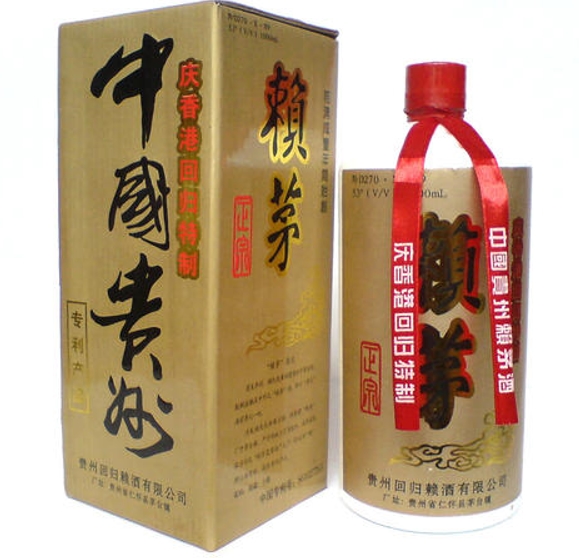
All kinds of "Lai Mao" wine.
As an important historical asset attached to Moutai, "Lai Mao" brand is the key to enhance the product premium of newly established liquor enterprises. The attached history has thus become a common phenomenon in the liquor industry. With regard to the story of "Lai Mao" in the Republic of China, Hu Wensui’s experience in designing the trademark of "Lai Mao" was almost annihilated. On the contrary, fictional urban legends spread widely. For example, "Lai Mao won the gold medal in the 1915 Panama World Expo" was a typical oolong in commercial marketing.
In a word, the trademark story of "Lai Mao" not only outlines a "dark line" in the social and economic history of the rear area of the Anti-Japanese War, but also runs through the ups and downs of the development history of liquor in the 20th century.